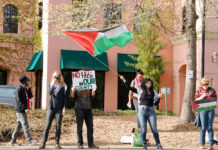I am bewildered by Toni Lisoni’s letter regarding debris burning
in the agriculture community. The connotative use of the word
debris is misleading (purposefully?). Only cuttings and brush are
allowed to be burned and that occurs less and less frequently.
Perhaps T. Lisoni does not have a historical perspective of where
we have been and the accomplishments made within a very short time.
If T. Lisoni does have a historical perspective, it would have been
nice to offer kudos for those accomplishments.
In the 50’s, 60’s and 70’s, most everyone burned cuttings from
prune trees, grape vines, apple trees, pear trees etc. Many folks
used: plastic waste, used auto oil, old tires, lumber (pressure
treated included) as starters. We also burned fields. We also
burned stumps. And…yes, we burned various debris. Circa 1963, I
remember my old neighbor burning a couple of huge eucalyptus stumps
with tires for about three weeks. It wasn’t just farmers, though.
Many city households in that era had back yard 50 gallon burn tubs.
There was a lot of “funny stuff” put into those toxic emitters as
well. These same households had or have fireplaces. Again, who
knows what went into fireplaces (even to this day). Fireplaces were
and are still unregulated in many parts of this country. Fireplaces
are now becoming regulated and fewer are being used in new
construction (at least in California). Agriculture has had
regulations pertinent to burns for many years preceding those of
personal households. In a society much less populated, there wasn’t
the urgency for regulating noxious gases and particulate matter. We
have grown in population and in knowledge. Agriculture has made and
continues to make changes in leaps and bounds in reducing the
impact of particulate matter and noxious gases.
Thanks to cost (it is cheaper to mulch the ag cuttings),
education, and compliance – with well written and thought out
regulations, we have eliminated the vast majority of burns. As I
run, ride, and drive around the beautiful Dry Creek, Russian River,
and Alexander Valleys, I see very few “burns” of brush. The few
burns I see are generally in vineyards where mulching is nearly
impossible. These difficult to mulch areas, in general, produce
some of the finer wines of our world class appellation. These areas
are usually very small in acreage.
When driving past a farm, check out some of the equipment
utilized by farmers. One of the staple tools in almost any of the
grape ranches is a mower (either flail or rotary). In fact, I don’t
know a single farmer that does not own a mower. These mowers are
used to mulch cuttings. Maybe to T. Lisoni’s surprise, it is
actually cheaper and quicker to mulch – in place – the cuttings of
the vines, versus carrying the cuttings out of the rows to a fire
safe area to do a burn. Many of these mowers also reduce the need
for cultivation of soil – helping to conserve soil.
As far as regulations, we have a limited season so that we can
burn safely. Burns are disallowed on days with inversion layers or
other unsafe weather conditions. This concentrates the few burnings
we have into a few days per year. We can only burn aged wood so
that it burns hotter and more complete. No more stumps or buildings
or fields (with rare exception). The items allowed to burn are
brush from that ranch and usually restricted at that. No more
tires, lumber, (pressure treated or otherwise), or unused auto oil
can be used as starters. The few agricultural burns that remain are
much safer than just twenty years ago and every year, there are
more improvements. Yet, there are items that are difficult to mulch
– such as large branches or trunks. Many of us out in the rural
areas must keep a fire safe zone next to structures. This requires
safe clearing and burning of large trunks and branches and as T.
Lisoni states – the mulchers for these items are very expensive and
not always easily mobile – hence a burn.
Please remember, that as neighbors, we share the same interest
in breathing clean air. Personally, as a care taker, I was very
sensitive to the “spare the air days” as my father suffered the
last years of his life with emphysema. There has been and continues
to be improvement in controlling smoke and pollution from the
agricultural side – every year. Maybe agriculture is just an easy
target because of the perceived success of the industry (T. Lisoni,
please note: attorneys have been easy targets for critics as well).
None the less, I am hoping that T. Lisoni would see and appreciate
the advances that have already taken place. I also hope that T.
Lisoni has taken the same initiative to reduce pollution through
good personal choices of renewable energy and transportation as
many of us in agriculture already have. We can then be partners
toward a cleaner and healthier environment.
Wayne Rogers is a Healdsburg resident.
61.6
F
Healdsburg
April 19, 2025







